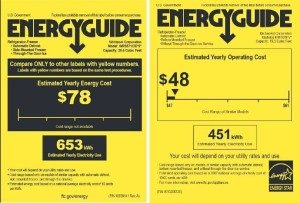Recently, I’ve gotten a lot of emails and calls from my builder clients about refrigerators. It seems their energy consumption has gotten confusing, particularly if you’re trying to buy an energy star model. There are two reasons for this: (1) the standard test for how much energy they use has changed, and (2) they’re compared to one another based on size.
They recently changed the test that they use to figure out how many kWh per year they use, so there are fridges out there right now with different test results. They also adopted new rules for whether a refrigerator can be Energy Star labeled in September 2014. If you look closely at the energy guide card, some have the kWh per year in yellow (new test) and some have it in black (old test). The ones tested using the old test have much lower kWh per year. I’ve had builders who ordered one based on the old test, but then it arrived with the new test label. So, they were frustrated because its energy use was worse than they ordered but it’s just the test that changed. The new numbers, though higher, are more similar to actual operating conditions, and should be a better predictor of energy use.

The graphic above shows a new energy guide on the left: the numbers are in yellow. On the right is an old energy guide, with the numbers in black. This isn’t the same refrigerator, but you can’t compare them anyway, because the newer one will be higher kWh. You can also see that the one on the right is Energy Star labeled, and the one on the left isn’t.
The other thing that can be confusing is that refrigerators are rated kind of like cars. An Energy Star refrigerator or freezer must use at least 10% less energy than the federal minimum efficiency. The federal minimum efficiency varies based on refrigerator size. So, a relatively efficient large refrigerator might earn the Energy Star label but still use more energy than a smaller refrigerator that doesn’t earn the label. That means that you should buy the smallest refrigerator that meets your needs. Just don’t buy two – it’s much more efficient to have one large refrigerator than it is to have two smaller ones.
In fact, size can be deceiving when buying refrigerators. On the very small end of the spectrum, performance is often terrible. And there are some VERY big units that use less than standard size units. Most of the big Sub-zeros, for instance, have very low energy use. We have had houses where the main large refrigerator uses about the same amount of energy as the under-counter half fridge in the bar. No one believes me.
Here’s a 15 cubic foot sub-zero with a freezer that uses 551 kWh per year. And here’s a 5 cubic foot refrigerator that uses 514 kWh per year. Both are actually Energy Star rated, so they use less energy than comparable refrigerators on the market. What does this mean? It pays to shop by kWh, because there’s a lot of variability out there. But it’s almost more important to limit the number of refrigerators that you have. Those little mini-fridges add up. I’ve seen homes with 3 or 4 of them. From an energy efficiency standpoint, it’s much better to centralize your home refrigeration.
A final thing to know is that refrigerators have gotten much more efficient over the last 30 years. And like anything else, that 30 year old refrigerator that you use for beer in your garage probably isn’t running at top performance anymore. So if your second refrigerator is old, you’re really inefficient. Duke Energy Progress will come to your house and get it and give you $50. So do something about it!
Copyright 2015. Amy Musser

